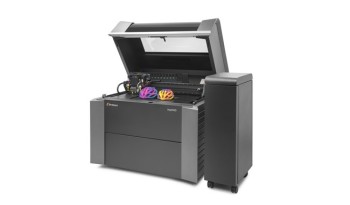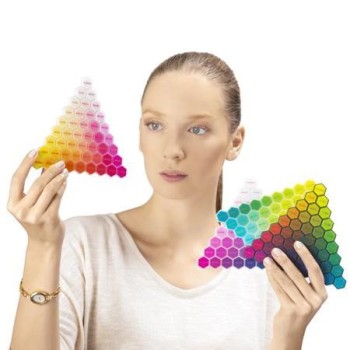
Stratasys’ Objet350 Connex3 is a mid-sized PolyJet printer that can be used for a wide variety of applications including functional prototypes, marketing, jig and fixtures and much more.
Similar to the company’s Connex2 models, the Connex3 employs triple-jetting technology to mix flexible and rigid bases to create Digital ABS materials with various properties. What sets the Connex3 line apart from previous models is its ability to jet user-defined color materials into a print.
With its expanded color palette, the Connex3 offers over 1000 Digital ABS materials. In addition, the system also supports:
- Two a simulated polypropylene materials (Durus and Endur), a high temperature material and bio-compatible material
- Two transparent materials (VeroClear and RGD720)
- A washable support material (SUP705)
Users can add an expanded material cabinet to the Connex3 to extend its operating time for larger print jobs. With a full material cabinet, jobs can be set on a Friday and left to print through the weekend without worry.
Given its size and audible print noise, the Connex3 should be used in its own work environment like a tool or machine shop. The printer does not produce any toxic or noxious odors.
The Objet350 Connex3 is a triple-jetting PolyJet 3D Printer that extrudes UV-curable liquid resin to create models.
To begin a print, the Connex3 establishes a multilayer platform of support material on the build platform. The initial support platform serves one critical purpose: it makes it easier to remove a model from the print bed once it’s complete.
The Connex3 then begins jetting the user-prescribed blend of liquid resin to build the model layer by layer. Once the print head jets its resin, a UV-curing lamp (built into the print head mechanism) fixes the liquid in place moments later. If support structures are needed to maintain overhangs, undercuts or other voids it will also be laid down during these build passes. This process continues until the model is complete.
Completed models can be scraped from the Connex3’s build plate and moved to a high-pressure water jet cabinet where their support material can be removed. The support structure can typically be removed in minutes, making post processing relatively quick and easy.
According to Stratasys, with its 14 material base options, up to 82 materials can be built into a single print. To add more than one digital material, CAD models will have to be split using a 0.001-inch gap that signifies the boundary/beginning for a new material.
Because the Connex3 supports such a wide array of colors and material properties, additional post processing like painting can be eliminated. Thanks to that feature the Connex3 has one of the quickest “print-to-processed” times in the 3D printing industry.
Read more at ENGINEERING.com


